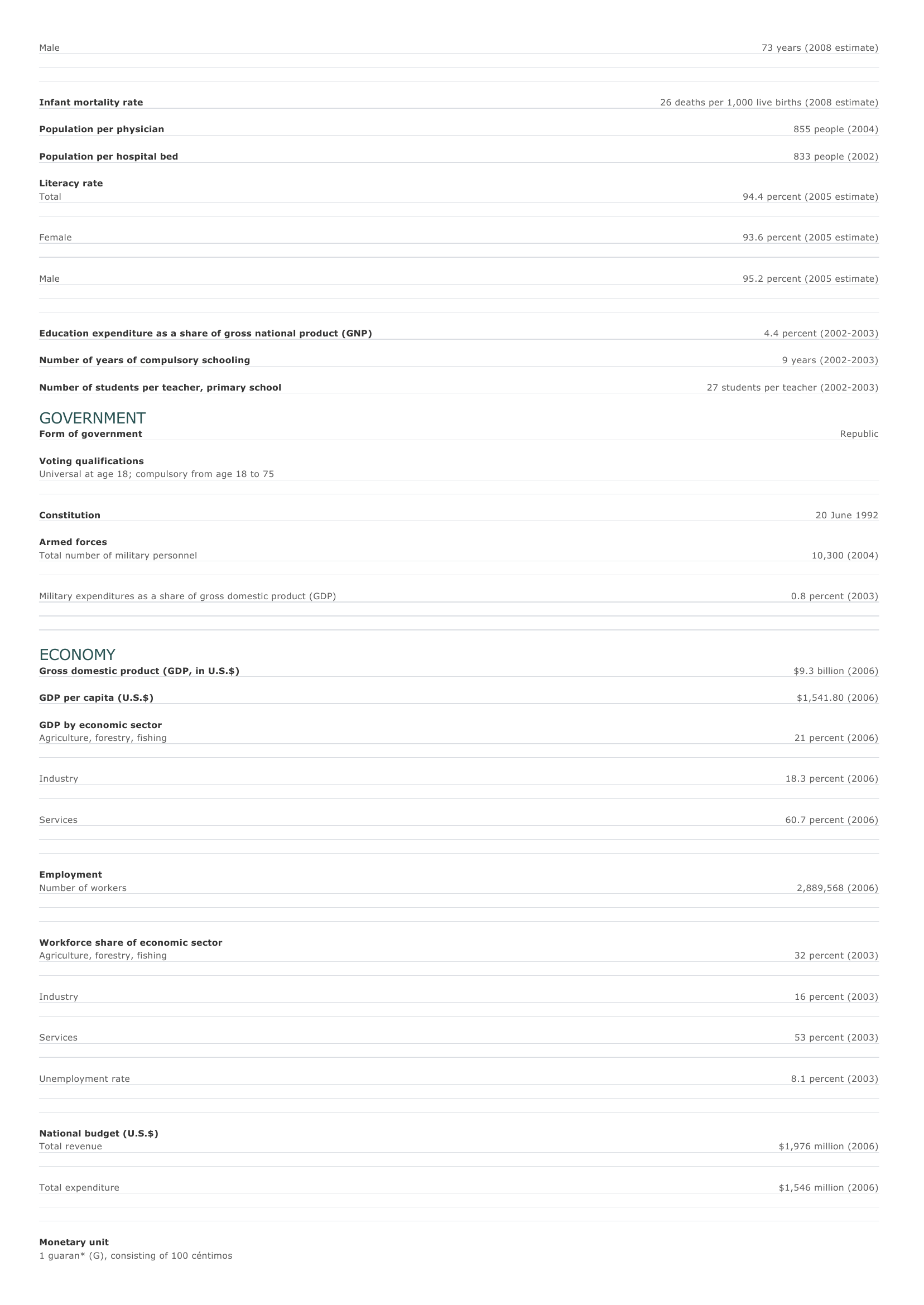
Paraguay Facts and Figures. BASIC FACTS Official name Capital Area Republic of Paraguay Asunción 406,752 sq km 157,048 sq mi PEOPLE Population 6,831,306 (2008 estimate) Population growth Population growth rate 2.39 percent (2008 estimate) Projected population in 2025 9,864,987 (2025 estimate) Projected population in 2050 14,604,978 (2050 estimate) Population density 17 persons per sq km (2008 estimate) 45 persons per sq mi (2008 estimate) Urban/rural distribution Share urban 58 percent (2005 estimate) Share rural 42 percent (2005 estimate) Largest cities, with population Asunción 519,647 (2005) Ciudad del Este 222,274 (2002) Encarnación 93,497 (2002) Concepción 73,210 (2002) Ethnic groups Mestizo European, Asian, Native American 95 percent 5 percent Languages Spanish (official), Guaran* (official), Portuguese Religious affiliations Roman Catholic 90 percent Protestant 4 percent Nonreligious 1 percent O ther 5 percent HEALTH AND EDUCATION Life expectancy Total 75.6 years (2008 estimate) Female 78.3 years (2008 estimate) Male Infant mortality rate 73 years (2008 estimate) 26 deaths per 1,000 live births (2008 estimate) Population per physician 855 people (2004) Population per hospital bed 833 people (2002) Literacy rate Total 94.4 percent (2005 estimate) Female 93.6 percent (2005 estimate) Male 95.2 percent (2005 estimate) Education expenditure as a share of gross national product (GNP) Number of years of compulsory schooling Number of students per teacher, primary school 4.4 percent (2002-2003) 9 years (2002-2003) 27 students per teacher (2002-2003) GOVERNMENT Form of government Republic Voting qualifications Universal at age 18; compulsory from age 18 to 75 Constitution 20 June 1992 Armed forces Total number of military personnel Military expenditures as a share of gross domestic product (GDP) 10,300 (2004) 0.8 percent (2003) ECONOMY Gross domestic product (GDP, in U.S.$) GDP per capita (U.S.$) $9.3 billion (2006) $1,541.80 (2006) GDP by economic sector Agriculture, forestry, fishing 21 percent (2006) I ndustry 18.3 percent (2006) Services 60.7 percent (2006) Employment Number of workers 2,889,568 (2006) Workforce share of economic sector Agriculture, forestry, fishing 32 percent (2003) I ndustry 16 percent (2003) Services 53 percent (2003) Unemployment rate 8.1 percent (2003) National budget (U.S.$) Total revenue $1,976 million (2006) Total expenditure $1,546 million (2006) Monetary unit 1 guaran* (G), consisting of 100 céntimos Major trade partners for exports Brazil, Argentina, Chile, Netherlands, and Spain Major trade partners for imports Brazil, Argentina, United States, Hong Kong SAR, and Uruguay ENERGY, COMMUNICATIONS, AND TRANSPORTATION Electricity production Electricity from thermal sources Electricity from hydroelectric sources Electricity from nuclear sources Electricity from geothermal, solar, and wind sources Number of radios per 1,000 people 0.03 percent (2003 estimate) 99.91 percent (2003 estimate) 0 percent (2003 estimate) 0.06 percent (2003 estimate) 182 (1997) Number of telephones per 1,000 people 54 (2005) Number of televisions per 1,000 people 215 (2000 estimate) Number of Internet hosts per 10,000 people 16 (2003) Daily newspaper circulation per 1,000 people 43 (1996) Number of motor vehicles per 1,000 people 88 (1999) Paved road as a share of total roads 51 percent (1999) SOURCES Basic Facts and People sections Area data are from the statistical bureaus of individual countries. Population, population growth rate, and population projections are from the United States Census Bureau, International Programs Center, International Data Base (IDB) (www.census.gov). Urban and rural population data are from the Food and Agriculture Organization (FAO) of the United Nations (UN), FAOSTAT database (www.fao.org). Largest cities population data and political divisions data are from the statistical bureaus of individual countries. Ethnic divisions and religion data are largely from the latest Central Intelligence Agency (CIA) World Factbook and from various country censuses and reports. Language data are largely from the Ethnologue, Languages of the World, Summer Institute of Linguistics International (www.sil.org). Health and Education section Life expectancy and infant mortality data are from the United States Census Bureau, International Programs Center, International database (IDB) (www.census.gov). Population per physician and population per hospital bed data are from the World Health Organization (WHO) (www.who.int). Education data are from the United Nations Educational, Scientific and Cultural Organization (UNESCO) database (www.unesco.org). Government section Government, independence, legislature, constitution, highest court, and voting qualifications data are largely from various government Web sites, the latest Europa World Yearbook, and the latest Central Intelligence Agency (CIA) World Factbook. The armed forces data is from Military Balance. Economy section Gross domestic product (GDP), GDP per capita, GDP by economic sectors, employment, and national budget data are from the World Bank database (www.worldbank.org). Monetary unit, agriculture, mining, manufacturing, exports, imports, and major trade partner information is from the statistical bureaus of individual countries, latest Europa World Yearbook, and various United Nations and International Monetary Fund (IMF) publications. Energy, Communication, and Transportation section Electricity information is from the Energy Information Administration (EIA) database (www.eia.doe.gov). Radio, telephone, television, and newspaper information is from the United Nations Educational, Scientific and Cultural Organization (UNESCO) database (www.unesco.org). Internet hosts, motor vehicles, and road data are from the World Bank database (www.worldbank.org). Note Figures may not total 100 percent due to rounding. Microsoft ® Encarta ® 2009. © 1993-2008 Microsoft Corporation. All rights reserved.





